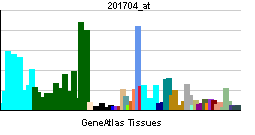ENTPD6
| Ectonucleoside triphosphate diphosphohydrolase 6 (putative function) | |||||||||
|---|---|---|---|---|---|---|---|---|---|
| Identifiers | |||||||||
| Symbols | ENTPD6 ; CD39L2; DKFZp781G2277; DKFZp781K21102; FLJ36711; IL-6SAG; IL6ST2; NTPDase-6; dJ738P15.3 | ||||||||
| External IDs | Template:OMIM5 Template:MGI HomoloGene: 68170 | ||||||||
| |||||||||
| RNA expression pattern | |||||||||
 | |||||||||
| More reference expression data | |||||||||
| Orthologs | |||||||||
| Template:GNF Ortholog box | |||||||||
| Species | Human | Mouse | |||||||
| Entrez | n/a | n/a | |||||||
| Ensembl | n/a | n/a | |||||||
| UniProt | n/a | n/a | |||||||
| RefSeq (mRNA) | n/a | n/a | |||||||
| RefSeq (protein) | n/a | n/a | |||||||
| Location (UCSC) | n/a | n/a | |||||||
| PubMed search | n/a | n/a | |||||||
Ectonucleoside triphosphate diphosphohydrolase 6 (putative function), also known as ENTPD6, is a human gene.[1]
ENTPD6 is similar to E-type nucleotidases (NTPases). NTPases, such as CD39, mediate catabolism of extracellular nucleotides. ENTPD6 contains 4 apyrase-conserved regions which is characteristic of NTPases.[1]
References
Further reading
- Chadwick BP, Frischauf AM (1997). "Cloning and mapping of a human and mouse gene with homology to ecto-ATPase genes". Mamm. Genome. 8 (9): 668–72. PMID 9271669.
- Chadwick BP, Frischauf AM (1998). "The CD39-like gene family: identification of three new human members (CD39L2, CD39L3, and CD39L4), their murine homologues, and a member of the gene family from Drosophila melanogaster". Genomics. 50 (3): 357–67. doi:10.1006/geno.1998.5317. PMID 9676430.
- Hicks-Berger CA, Chadwick BP, Frischauf AM, Kirley TL (2000). "Expression and characterization of soluble and membrane-bound human nucleoside triphosphate diphosphohydrolase 6 (CD39L2)". J. Biol. Chem. 275 (44): 34041–5. doi:10.1074/jbc.M004723200. PMID 10948193.
- Yeung G, Mulero JJ, McGowan DW; et al. (2000). "CD39L2, a gene encoding a human nucleoside diphosphatase, predominantly expressed in the heart". Biochemistry. 39 (42): 12916–23. PMID 11041856.
- Hartley JL, Temple GF, Brasch MA (2001). "DNA cloning using in vitro site-specific recombination". Genome Res. 10 (11): 1788–95. PMID 11076863.
- Wiemann S, Weil B, Wellenreuther R; et al. (2001). "Toward a catalog of human genes and proteins: sequencing and analysis of 500 novel complete protein coding human cDNAs". Genome Res. 11 (3): 422–35. doi:10.1101/gr.154701. PMID 11230166.
- Deloukas P, Matthews LH, Ashurst J; et al. (2002). "The DNA sequence and comparative analysis of human chromosome 20". Nature. 414 (6866): 865–71. doi:10.1038/414865a. PMID 11780052.
- Strausberg RL, Feingold EA, Grouse LH; et al. (2003). "Generation and initial analysis of more than 15,000 full-length human and mouse cDNA sequences". Proc. Natl. Acad. Sci. U.S.A. 99 (26): 16899–903. doi:10.1073/pnas.242603899. PMID 12477932.
- Ivanenkov VV, Murphy-Piedmonte DM, Kirley TL (2004). "Bacterial expression, characterization, and disulfide bond determination of soluble human NTPDase6 (CD39L2) nucleotidase: implications for structure and function". Biochemistry. 42 (40): 11726–35. doi:10.1021/bi035137r. PMID 14529283.
- Ota T, Suzuki Y, Nishikawa T; et al. (2004). "Complete sequencing and characterization of 21,243 full-length human cDNAs". Nat. Genet. 36 (1): 40–5. doi:10.1038/ng1285. PMID 14702039.
- Gerhard DS, Wagner L, Feingold EA; et al. (2004). "The status, quality, and expansion of the NIH full-length cDNA project: the Mammalian Gene Collection (MGC)". Genome Res. 14 (10B): 2121–7. doi:10.1101/gr.2596504. PMID 15489334.
- Wiemann S, Arlt D, Huber W; et al. (2004). "From ORFeome to biology: a functional genomics pipeline". Genome Res. 14 (10B): 2136–44. doi:10.1101/gr.2576704. PMID 15489336.
- Otsuki T, Ota T, Nishikawa T; et al. (2007). "Signal sequence and keyword trap in silico for selection of full-length human cDNAs encoding secretion or membrane proteins from oligo-capped cDNA libraries". DNA Res. 12 (2): 117–26. doi:10.1093/dnares/12.2.117. PMID 16303743.
- Mehrle A, Rosenfelder H, Schupp I; et al. (2006). "The LIFEdb database in 2006". Nucleic Acids Res. 34 (Database issue): D415–8. doi:10.1093/nar/gkj139. PMID 16381901.
- Lim J, Hao T, Shaw C; et al. (2006). "A protein-protein interaction network for human inherited ataxias and disorders of Purkinje cell degeneration". Cell. 125 (4): 801–14. doi:10.1016/j.cell.2006.03.032. PMID 16713569.
| This protein-related article is a stub. You can help Wikipedia by expanding it. |